|
|
|
|
|
Asetek VapoChill Mk2 Premium Edition |
|
Join the community - in the OCAU Forums!
|
Overclocking
Overclocking
Of course, there's no point running your CPU at nice low temperatures unless you're going to overclock it. Indeed, one way the cost of the VapoChill is justified, is that you can save money by buying a cheaper processor and running it at the cost of a faster processor. However, you need to factor in that overclocking is possible with a range of much cheaper coolers, including the stock cooler that ships with most retail CPU's. This is especially true of recent P4's, which overclock mightily even with the retail cooler.
I must also stress that we only tested a single CPU. Obviously, as with any overclocking project, results from one CPU to another will vary. Our results are only an indication of what can be achieved - your own will vary on one side or the other of ours, in terms of percentage gain.
Anyway, when aircooled using the stock cooler, our lowly P4 2.0A could reach 2.66GHz at default voltage. This simple switch from 100MHz FSB (400MHz QDR) to 133MHz FSB (533MHz QDR) is fairly impressive by itself.
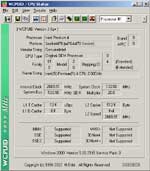
This is the highest speed I would call totally stable. Bear in mind that we were testing the aircooled system sitting on a desk, not in a case. In an enclosed case you may get lower results, depending on airflow.
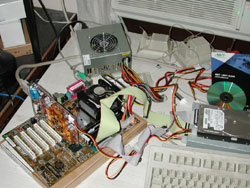
There are a range of more effective coolers for the P4 out there. I don't have any here for testing, but I don't think it's entirely fair to compare the VapoChill to only the retail aircooler. Therefore I'm going to be somewhat unscientific and also include results from running the P4 at 2.79GHz aircooled, even though the machine wasn't 100% stable over 2.66GHz. The core voltage was boosted to the maximum the BE7 permits, +15%, and the machine wasn't entirely stable, but I think with a more serious aircooler it would be realistic to expect closer to this speed. I could run most tasks ok, but POV-ray would sometimes report an error or 3DMark2001 would drop back to the desktop. Also, it wouldn't cleanly reboot or power up every time at this speed. This borderline instability is exactly the kind of thing that can often be fixed with better cooling (or more core voltage, sadly unavailable on the BE7).
Note that this is a different type of error to the R9700 issue on the previous page, where it would run POV-ray and other benchmarks fine for hours on end, but lock the machine solid during 3DMark or Quake3.
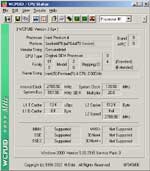
Putting the system into the VapoChill let me run 2.79GHz completely stable. Of course, we don't stop there.
For the top-speed test I booted into the ChillControl software and set everything to what sounded like the maximum - fans to 100%, evaporator temp to idle at -30C from the default of -15C and to not to start the system until the evaporator temp dropped to -20C. This made a dramatic difference, with the on-die temperature reported by MBM reaching -3C at idle and evaporator temp getting down to -29C or so, reported on the ChillControl.
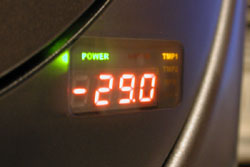
I so wanted to break the 3GHz barrier stably, but alas, the best I could manage was 2990MHz. 10MHz stood between me and glory, curse it. At 3GHz (150MHz FSB x 20) the system would boot fine and be ok for basic tasks, but 3DMark would vanish and spit me back to the desktop. Dropping back to 149MHz FSB let me run benchmarks to my heart's content - I even ran several torture-tests of Folding@Home, the POV-ray rendering benchmark and 3DMark2001, all at the same time.
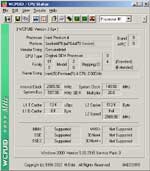
How much difference does that make to performance? On the next page, we break out the benchmarks.
|
|
Advertisement:
All original content copyright James Rolfe.
All rights reserved. No reproduction allowed without written permission.
Interested in advertising on OCAU? Contact us for info.
|

|


